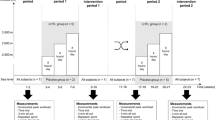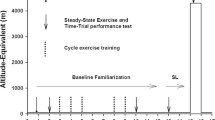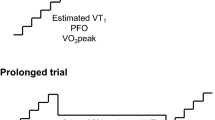Abstract
Athletes regularly compete at 2,000–3,000 m altitude where peak oxygen consumption \((\dot{V}\hbox{\rm O}_{2{\rm peak}})\) declines ∼10–20%. Factors other than \(\dot{V}\hbox{\rm O}_{2{\rm peak}}\) including gross efficiency (GE), power output, and pacing are all important for cycling performance. It is therefore imperative to understand how all these factors and not just \(\dot{V}\hbox{\rm O}_{2{\rm peak}}\) are affected by acute hypobaric hypoxia to select athletes who can compete successfully at these altitudes. Ten well-trained, non-altitude-acclimatised male cyclists and triathletes completed cycling tests at four simulated altitudes (200, 1,200, 2,200, 3,200 m) in a randomised, counter-balanced order. The exercise protocol comprised 5 × 5-min submaximal efforts (50, 100, 150, 200 and 250 W) to determine submaximal \(\dot{V}\hbox{\rm O}_{2}\) and GE and, after 10-min rest, a 5-min maximal time-trial (5-minTT) to determine \(\dot{V}\hbox{\rm O}_{2{\rm peak}}\) and mean power output (5-minTTpower). \(\dot{V}\hbox{\rm O}_{2{\rm peak}}\) declined 8.2 ± 2.0, 13.9 ± 2.9 and 22.5 ± 3.8% at 1,200, 2,200 and 3,200 m compared with 200 m, respectively, P < 0.05. The corresponding decreases in 5-minTTpower were 5.8 ± 2.9, 10.3 ± 4.3 and 19.8 ± 3.5% (P < 0.05). GE during the 5-minTT was not different across the four altitudes. There was no change in submaximal \(\dot{V}\hbox{\rm O}_{2}\) at any of the simulated altitudes, however, submaximal efficiency decreased at 3,200 m compared with both 200 and 1,200 m. Despite substantially reduced power at simulated altitude, there was no difference in pacing at the four altitudes for athletes whose first trial was at 200 or 1,200 m; whereas athletes whose first trial was at 2,200 or 3,200 m tended to mis-pace that effort. In conclusion, during the 5-minTT there was a dose–response effect of hypoxia on both \(\dot{V}\hbox{\rm O}_{2{\rm peak}}\) and 5-minTTpower but no effect on GE.




Similar content being viewed by others
References
Amann M, Eldridge MW, Lovering AT, Stickland MK, Pegelow DF, Dempsey JA (2006) Arterial oxygenation influences central motor output and exercise performance via effects on peripheral locomotor muscle fatigue in humans. J Physiol 575(Pt 3):937–952
Coyle EF, Coggan AR, Hopper MK, Walters TJ (1988) Determinants of endurance in well-trained cyclists. J Appl Physiol 64:2622–2630
Coyle EF, Sidossis LS, Horowitz JF, Beltz JD (1992) Cycling efficiency is related to the percentage of type I muscle fibers. Med Sci Sports Exerc 24:782–788
Craig NP, Norton KI, Bourdon PC, Woolford SM, Stanef T, Squires B, Olds TS, Conyers RAJ, Walsh CBV (1993) Aerobic and anaerobic indices contributing to track endurance cycling performance. Eur J Appl Physiol 67:150–158
Dempsey JA, Hanson PG, Henderson KS (1984) Exercise-induced arterial hypoxaemia in healthy human subjects at sea level. J Physiol 355:161–175
Elia MG, Livesey G (1992) Energy expenditure and fuel selection in biological systems: The theory and practice of calculation based on indirect calorimetry and tracer methods. In: Simopolous AP (ed) Metabolic control of eating, energy expenditure and the bioenergetics of obesity. Karger, Basel, pp 68–131
Faria EW, Parker DL, Faria IE (2005) The science of cycling: factors affecting performance—part 2. Sports Med 35:313–337
Fernández-García B, Peréz-landaluce J, Rodríguez-Alonso M, Terrados N (2000) Intensity of exercise during road race pro-cycling competition. Med Sci Sports Exerc 32:1002–1006
Finn JP, Maxwell BF, Withers RT (2000) Air braked cycle ergometers: validity of the correction factor for barometric pressure. Int J Sports Med 21:488–491
Foster C, Snyder AC, Thompson NN, Green MA, Foley M, Schrager M (1993) Effect of pacing strategy on cycle time trial performance. Med Sci Sports Exerc 25:383–388
Gore CJ, Hahn AG, Scroop GC, Watson DB, Norton KI, Wood RJ, Campbell DP, Emonson DL (1996) Increased arterial desaturation in trained cyclists during maximal exercise at 580 m altitude. J Appl Physiol 80:2204–2210
Gore CJ, Little SC, Hahn AG, Scroop GC, Norton KI, Bourdon PC, Woolford SM, Buckley JD, Stanef T, Campbell DP, Watson DB, Emonson DL (1997) Reduced performance of male and female athletes at 580 m altitude. Eur J Appl Physiol Occup Physiol 75:136–143
Green HJ, Roy B, Hughson R, Burnett M, Otto C, Pipe A, McKezie D, Johnson M (2000) Increases in submaximal cycling efficiency mediated by altitude acclimatization. J Appl Physiol 89:1189–1197
Hawley JA and Noakes TD (1992) Peak power output predicts maximal oxygen uptake and performance time in trained cyclists. Eur J Appl Physiol Occup Physiol 65:79–83
Hochachka PW, Stanley C, Matheson GO, McKenzie DC, Allen PS, Parkhouse WS (1991) Metabolic and work efficiencies during exercise in Andean natives. J Appl Physiol 70:1720–1730
Koistinen P, Takala T, Martikkala V, Leppaluoto J (1995) Aerobic fitness influences the response of maximal oxygen uptake and lactate threshold in acute hypobaric hypoxia. Int J Sports Med 26:78–81
de Koning JJ, Bobbert MF, Foster C (1999) Determination of optimal pacing strategy in track cycling with an energy flow model. J Sci Med Sport 2:266–277
Lawler J, Powers SK, Thompson D (1988) Linear relationship between \(\dot{V}\hbox{\rm O}_{2{\rm max}}\) and \(\dot{V}\hbox{\rm O}_{2{\rm max}}\) decrement during exposure to acute hypoxia. J Appl Physiol 64:1486–1492
Lucía A, Hoyos J, Peréz M, Santalla A, Chicharro JL (2002) Inverse relationship between \(\dot{V}\hbox{\rm O}_{2{\rm max}}\) and economy/efficiency in world-class cyclists. Med Sci Sports Exerc 34:2079–2084
Lucía A, San Juan AF, Montilla M, Canete S, Santalla A, Earnest C, Pérez M (2004) In professional road cyclists, low pedaling cadences are less efficient. Med Sci Sports Exerc 36:1048–1054
Lundby C, Calbet JA, Sander M, van Hall G, Mazzeo RS, Stray-Gundersen J, Saltin B, Levine BD (2007) Exercise economy does not change during or after acclimatization to moderate to very high altitude. Scand J Med Sci Sports 17(3):281–291
MacIntosh BR, Neptune RR, Horton JF (2000) Cadence, power, and muscle activation in cycle ergometry. Med Sci Sports Exerc 32:1281–1287
Moseley L, Jeukendrup AE (2001) The reliability of cycling efficiency. Med Sci Sports Exerc 33:621–627
Moseley L, Achten J, Martin JC, Jeukendrup AE (2004) No differences in cycling efficiency between world-class and recreational cyclists. Int J Sports Med 25:374–379
Noakes TD, Peltonen JE, Rusko H (2001) Evidence that a central governor regulates exercise performance during acute hypoxia and hyperoxia. J Exp Biol 204:3225–3234
Olds TS (1992) The optimal altitude for cycling performance: a mathematical model. Excel 8:155–159
Peltonen JE, Tikkanen HO, Rusko HK (2001) Cardiorespiratory responses to exercise in acute hypoxia, hyperoxia and normoxia. Eur J Appl Physiol 85:82–88
Peltonen JE, Rantamaki J, Niittymaki SP, Sweins K, Viitasalo JT, Rusko, HK (1995) Effects of oxygen fraction in inspired air on rowing performance. Med Sci Sports Exerc 27(4):573–579
Péronnet F, Bouissou P, H. Perrault H, Ricci J (1991). The one hour cycling record at sea level and at altitude. Cycl Sci 3:16–22
Powers SK, Lawler J, Dempsey JA, Dodd S, Landry G (1989) Effects of incomplete pulmonary gas exchange on \(\dot{V}\hbox{\rm O}_{2{\rm max}}\). J Appl Physiol 66:2491–2495
Powers SK, Martin D, Cicale M, Collop N, Huang D, Criswell D (1992) Exercise-induced hypoxemia in athletes: role of inadequate hyperventilation. Eur J Appl Physiol Occup Physiol 65:37–42
Powers SK, Martin D, Dodd S (1993) Exercise-induced hypoxaemia in elite endurance athletes. Incidence, causes and impact on \(\dot{V}\hbox{\rm O}_{2{\rm max}}\). Sports Med 16:14–22
Pugh LG, Gill MB, Lahiri S, Milledge JS, Ward MP, West JB (1964) Muscular exercise at great altitudes. J Appl Physiol 19:431–440
R Development Core Team (2005) R: A language and environment for statistical computing. R Foundation for Statistical Computing, Vienna, Austria. ISBN 3-900051-07-0
Robergs RA, Quintana R, Parker DL, Frankel CC (1998) Multiple variables explain the variability in the decrement in \(\dot{V}\hbox{\rm O}_{2{\rm max}}\) during acute hypobaric hypoxia. Med Sci Sports Exerc 30:869–879
Stanef T (1988) Preliminary report on dynamic calibration rig for ascertaining accuracy of ergometer in the health and exercise sciences. Motion Technology, pp 2–3
Wehrlin JP, Hallen J (2006) Linear decrease in \(\dot{V}\hbox{\rm O}_{2{\rm max}}\) and performance with increasing altitude in endurance athletes. Eur J Appl Physiol, pp 1–9
West JB, Boyer SJ, Graber DJ, Hackett PH, Maret KH, Milledge JS, Peters RM, Pizzo CJ, Samaja M, Sarnquist FH, Schoene RB, Winslow RM (1983) Maximal exercise at extreme altitudes on Mount Everest. J Appl Physiol 55(3):688–698
Withers RT, Gore CJ, Gass G, Hahn A (2000) Determination of maximal oxygen consumption (\(\dot{V}\hbox{\rm O}_{2{\rm max}}\)) or maximal aerobic power. In: Gore CJ (ed) Physiological tests for elite athletes. Human Kinetics, Champaign, pp 114–127
Wolfel EE, Groves BM, Brooks GA, Butterfield GE, Mazzeo RS, Moore LG, Sutton JR, Bender PR, Dahms TE, McCullough RE (1991) Oxygen transport during steady-state submaximal exercise in chronic hypoxia. J Appl Physiol 70:1129–1136
Woolford SM, Withers RT, Craig NP, Bourdon PC, Stanef T, McKenzie I (1999) Effect of pedal cadence on the accumulated oxygen deficit, maximal aerobic power and blood lactate transition thresholds of high-performance junior endurance cyclists. Eur J Appl Physiol 80:285–291
Yamaya Y, Bogaard HJ, Wagner PD, Niizeki K, Hopkins SR (2002) Validity of pulse oximetry during maximal exercise in normoxia, hypoxia and hyperoxia. J Appl Physiol 92:162–168
Acknowledgments
We thank our participants for their time and enthusiasm in this arduous study. We thank the Royal Australian Air Force for access to RAAF Base Edinburgh and the Aviation Medicine facility. We also gratefully acknowledge the outstanding work of RAAF technicians, Flight Seargent Mark Gegenhuber, Seargent William Jackson, Seargent Michael Johnson, Corporal Billy Hangan and Corporal Troy Starr for their unfailing humour and great skill in operating the hypobaric chamber. Statistical advice was provided by Dr Ken Sharpe, The University of Melbourne. The administrative and logistical support of Julie Hill was also most appreciated.
Author information
Authors and Affiliations
Corresponding author
Rights and permissions
About this article
Cite this article
Clark, S.A., Bourdon, P.C., Schmidt, W. et al. The effect of acute simulated moderate altitude on power, performance and pacing strategies in well-trained cyclists. Eur J Appl Physiol 102, 45–55 (2007). https://doi.org/10.1007/s00421-007-0554-0
Accepted:
Published:
Issue Date:
DOI: https://doi.org/10.1007/s00421-007-0554-0




